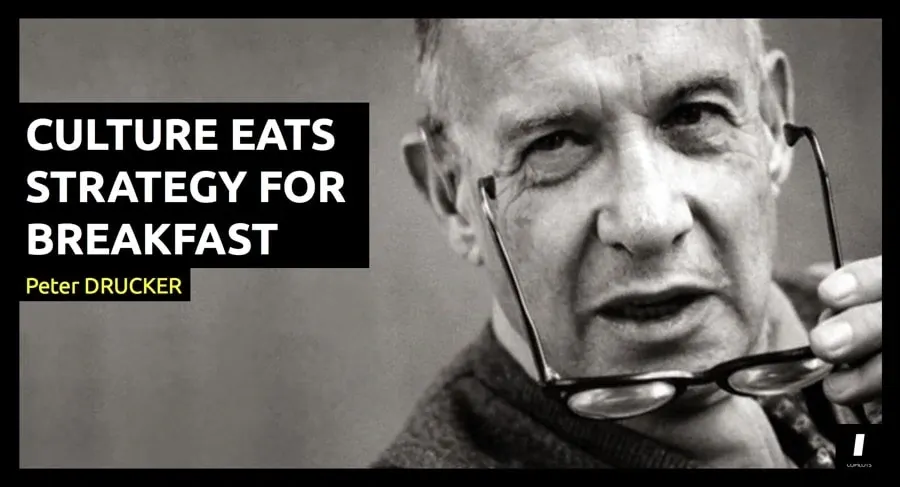🔳 Our culture framework

Philippe had been hinting at one of the combined tools we’d like to share: the culture and innovation frameworks. The culture framework that we’ve been using for years informally when helping organisations in their strategic transformations is the “other side” of the innovation framework Philippe has been sharing for a while now. We redesigned it recently and tested it extensively with our more recent customers to ensure that it’s practical and actionable for anyone not in the consulting business : )
You will see how it regroups and connects concepts I’ve been sharing in previous articles such as values, vision, and behaviours, and key elements I’ve been hinting to when talking about complexity intelligence: purposeful drive, strategic empathy, and reconfigurable mindset.
These concepts are usually fuzzy, and it’s difficult to see why they would matter on any Monday morning at the office. It shouldn’t be that way.
The culture framework we want to share is not about metaphysics and big ideas that no one will ever have to challenge. It is a strategic view of culture:

We made sure it wasn’t overly descriptive, as culture can be complex to look at. Indeed, we’ve experienced that even though leaders find working on culture very interesting, they get easily overwhelmed by the scope and lose interest once it becomes disconnected from strategy.
The culture framework is made of three key parts: connect or how the organisation is connected to its environment, lead or how it sets itself in movement and operate or how its internal workings impact the market.
CONNECT

It is its capacity to “sense” its environment. An organisation can have more or fewer connections just like individuals. We measure its level with the number of active touchpoints able to capture data from its internal and external environments.
Touchpoints can be varied from very metrics-driven online customer data capture to subjective mood boards, from direct customer feedback to employee engagement surveys, from networking events and industry conferences to internal startup incubators, and from personal network connections to engagement in professional communities. A touchpoint is a point of contact between the organisation and reality: its market and wider ecosystem.
The organisation evolves in a specific environment or ecosystem (the global community of people and organisations interacting with it).
Most of the time, the organisation is mainly concerned with its stakeholders in its ecosystem: shareholders, customers, suppliers, employees, partners, some interest groups, unions, etc. If everyone knows about the stakeholders, we usually don’t identify the bystanders: the loosely connected people and organisations gravitating but not yet engaged by the company. Bystanders can range from startups on your radar, not yet explored markets, unusual competitors, social media followers. They are key for the organisation capacity to be receptive to unexpected changes and to innovate.
The way the organisation is connected to its environment leads to an increased capacity to capture or sense certain data before others: it is its sixth sense. And also makes the organisation less aware of other data or parts of its reality; we call these elements its blindspots.
L’Oréal for example has created a programme to encourage women in digital. This is not just a marketing ploy to gain more brand value, it is a different way to be connected to its environment, listen to the bystanders and nourish its 6th sense about women’s needs.
Understanding your culture and its potential to support your business strategy is about knowing how connected your organisation is and what it is receptive to.
LEAD

To understand and be able to maximise an organisation’s lead, we look at the key values that energize your teams into actions, to go beyond their job description and engage enthusiastically.
Values are what is considered important by the organisation: what is “valued” and rewarded, what is sought, and what is motivating. Beyond the usually publicized buzzwords, there are deep drivers that really move the organisations, which employees live daily. They usually come from the foundation of the organisation, its history, its social and industrial context. They are evolving slowly as the organisation ages and grows and as its environment changes.
Of course, the lead and the values the organisation carries are often materialized or communicated via the vision statement. The vision can become a very powerful “why” statement upon which employees’ alignment and empowerment depend.
Alignment is how you ensure there is a clear and obvious connection between the defined vision and the objectives of management and their teams. This is usually the role of managers to cascade down and translate the strategy into more operational goals. It is key to ensure a coherent lead of the whole organisation, but it can be a “lost in translation” exercise if the vision is not coherent with the values.
With alignment comes the potential for empowerment, which is the degree of autonomy employees have in how they contribute to the vision. Empowerment has become one of these nice managerial buzzwords but very few companies really trust their employees to make the “right” decision on their own and willingly act in the best interest of the organisation.
Netflix is a great example of empowerment. They have ensured via their culture deck that the values are shared and understood throughout the company (for alignment purposes). Their two keywords are “freedom and responsibility,” which are not just buzzwords for them as they invested the time to ensure the meaning is shared. It is illustrated in their travel expenses policy, which says: “Act in the best interest of Netflix” or “spend as if it was your own money” (trusting and empowering employees to decide for themselves).
Understanding and benefiting from the company culture is about knowing what drives the organisation and how to activate it coherently throughout.
OPERATE

It is an ensemble of patterns of thinking, and assumptions that are made about self and the world that are illustrated or observable through its way of working: its behaviours.
The operations are mainly observed through how the company behaves: how employees work, what technology they use, what processes are in place, who reports to who, how people communicate, and how decisions are made.
One key consequence of “operate” is the company organisation: its structure, who has power, how people are interconnected to work together, workflow, and knowledge management.
The organisation itself is framed by its key processes: the main activities of the organisation, including what people do, how they work and interact; and its biases: the assumptions made by the organisation that influences the behaviours.
For example, Amazon has a “no PowerPoint” policy and a clear process for presenting ideas in a meeting: the presenter prepares a 6-page memo called a “narrative” at the meeting, people have 20 minutes to read it, and then ensues a time to answer questions. This process is coherent with their no-bullshit move-fast efficiency mindset and the assumptions (or biases) that “bullet-points kill meaning and depth of an idea” and “executives will bluff their way in the meeting as if they have read the memo”.
Ensuring that your culture is coherent and powerfully supporting your strategy is about understanding and readjusting your organisation’s operate aspects and patterns of behaviours.
And this is us…
Applied to us as a consulting company, it took about 15 min to fill out our culture framework. Of course, we know who we are and where we stand. It also helps that we’re not 5,000 employees.

But the more you are, the more it becomes critical to boil down your culture to a connected framework that makes sense and delivers strategic and operational perspectives.
Business and culture frameworks
The culture framework is only one side of the whole tool; this is why in future articles, we will share how it is connected to the business side. I will write soon about how different company DNAs impact or interact with culture and also how to develop certain types of cultures using the framework, for example, infusing organizational resilience and complexity intelligence into your culture.



